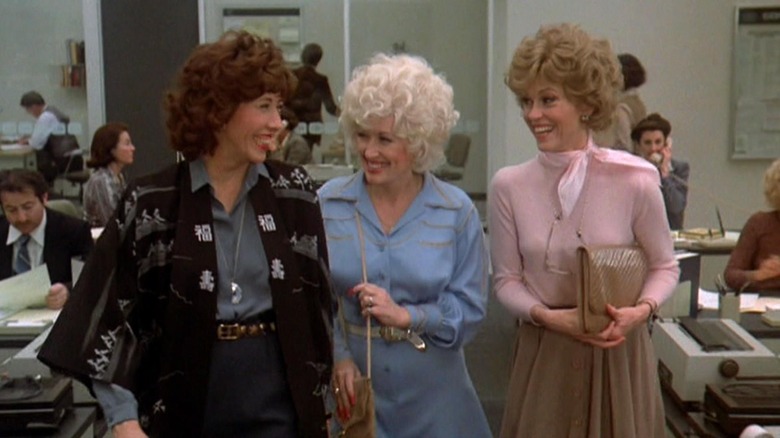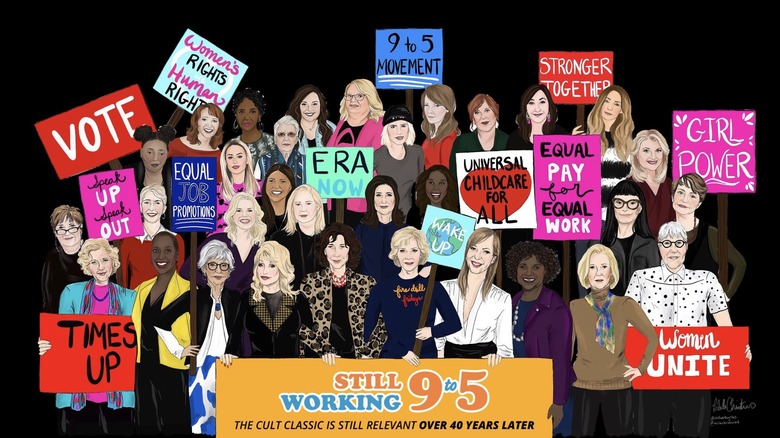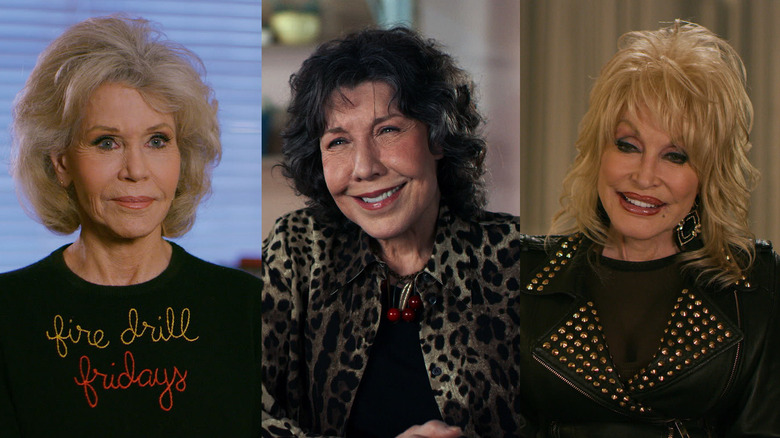You Can't Watch An Incredible Doc Because Hollywood Decision-Makers Are Cowards
With hindsight being 20/20 and all, it may be a shock to learn that when Jane Fonda and producing partner Bruce Gilbert wanted to make a workplace comedy about three secretaries who decide to enact revenge on their tyrannical, chauvinist boss called "9 to 5," few people (see: men) in positions of power thought the film would be a success. And yet, the film — which got its name after a grassroots organization of women fighting for workplace equality and fair pay (that is still around today) — was a box-office smash, launched the mainstream career of Dolly Parton outside of music, and inspired both a TV adaptation and a Broadway musical.
Featuring interviews with Parton, Fonda, Lily Tomlin, countless others who worked on the film, the TV adaptation (Rita Moreno!), the Broadway musical (Allison Janney!), and activists from then and now, the documentary "Still Working 9 to 5" currently boasts a 93% critical score. Variety called the film a "well-crafted doc" that "succeeds as both a 'making of' celebration and a cautionary reminder," while The Hollywood Reporter declared it, "a sparky oral history and a tribute to the power of pop culture to spotlight tough problems." The film also received 10 "Best Documentary" awards during its festival run and a Critics Choice Awards nomination for Best Historical Documentary. However, there are no audience reviews for this film.
Why? Because the decision-makers responsible for acquisitions and distribution at studios, networks, and streamers are all cowards, and they continue to prove the point of both "9 to 5" and the documentary's declaration that things haven't changed all that much for women in the workplace since the film debuted over four decades ago.
Barely gettin' by, it's all takin' and no givin'
Directed by Camille Hardman and Gary Lane, "Still Working 9 to 5" is a story of how the beloved comedy came to be, a look at the film's continued cultural relevance, and — perhaps most importantly — a look at the progression (or lack thereof) of workplace equality. The doc brings in activists from the time the film came to be, as well as those still working today, and shines a light on the fact that the Equal Rights Amendment — written over 100 years ago by Alice Paul and Crystal Eastman and introduced in Congress in December 1923 — has still not passed as a proposed amendment to the United States Constitution, despite meeting all the requirements for its publication as the 28th Amendment to the Constitution.
What made "9 to 5" such a cultural touchstone wasn't just the stellar cast and catchy title track, but also because the film's approach to issues like sexual harassment, gender-based discrimination, and workplace inequity were tragically relatable for moviegoers at the time. The fact that 40 years have passed, and "9 to 5" is just as relatable today, is an abject shame. This makes it doubly frustrating that "Still Working 9 to 5" has yet to receive distribution. The subject matter is timely, the film remains popular, and the stars have remained beloved icons — even in the eyes of people who weren't alive when they were at their height of fame.
Hell, Dolly Parton just collaborated with Beyoncé on a country album, while Jane Fonda and Lily Tomlin went viral multiple times during the press run for "80 for Brady" for being "bestie goals." No argument holds water as to why this documentary shouldn't be available to watch, at least not one that isn't rooted in misogyny. I'm sure some executive number crunchers who had to declare a loss on their "Bored Ape" investments on their taxes this year have tried to claim there's "no audience" for this film, but I'm calling bull.
Be your own cup of ambition
Gender equality in the workplace should be a no-brainer, and yet it's 2024, and according to a recent study, the gender pay gap still exists. "Women's labor force participation is the highest it has been in decades, and the gender pay gap is the narrowest it has ever been on record. Yet, despite this progress [...] women working full-time and year-round are paid an average of 84 cents for every dollar paid to men." This is looking only at cisgender inequality and not other intersections like race, sexuality, transgender identity, or disability status. Given the serious subject matter of "9 to 5," the film could have easily been a serious, Oscar-baiting drama about the workplace, but Fonda and Bruce Gilbert knew that in order for people to actually show up and see the film to receive the message, it would need to be a comedy.
And that's the real rip regarding so many "women's stories" in cinema. For as much as people lamented that "Barbie" was "feminism 101," the obscene backlash from some toward the film's very surface-level themes was enough to prove the need for the film to exist in the first place. What elevates "Still Working 9 to 5" is not that this is two documentaries in one, but the way that both the film "9 to 5" and the real-life fight for workplace equality are interwoven together.
"9 to 5" was a rallying cry for activism and another example of the power of cinema. This film radicalized countless people who watched the film and gave them the language to express the frustrations they were experiencing in their daily lives. Just like "9 to 5," the serious issues presented in "Still Working 9 to 5" are delivered in an entertaining and accessible way that will have you feeling motivated to get out there and fight the good fight, rather than feel like you just sat through a college lecture.
When "9 to 5" first came out, critics were mixed on the film, with The Washington Post saying it "runs a merely weak comic premise into the ground with coarse, laborious execution." And yet the film turned out to be a financial hit. History is once again repeating itself with the lack of distribution for "Still Working 9 to 5," so it's up to us to continue the fight to be heard.


